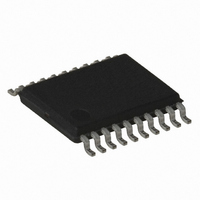ATTINY167-15XD Atmel, ATTINY167-15XD Datasheet - Page 165

ATTINY167-15XD
Manufacturer Part Number
ATTINY167-15XD
Description
MCU AVR 16K FLASH 15MHZ 20-TSSOP
Manufacturer
Atmel
Series
AVR® ATtinyr
Datasheet
1.ATTINY167-15MD.pdf
(283 pages)
Specifications of ATTINY167-15XD
Core Processor
AVR
Core Size
8-Bit
Speed
16MHz
Connectivity
I²C, LIN, SPI, UART/USART, USI
Peripherals
Brown-out Detect/Reset, POR, PWM, Temp Sensor, WDT
Number Of I /o
16
Program Memory Size
16KB (8K x 16)
Program Memory Type
FLASH
Eeprom Size
512 x 8
Ram Size
512 x 8
Voltage - Supply (vcc/vdd)
2.7 V ~ 5.5 V
Data Converters
A/D 11x10b
Oscillator Type
Internal
Operating Temperature
-40°C ~ 150°C
Package / Case
20-TSSOP
Processor Series
ATTINY1x
Core
AVR8
Data Bus Width
8 bit
Data Ram Size
512 B
Maximum Clock Frequency
16 MHz
Maximum Operating Temperature
+ 85 C
Mounting Style
SMD/SMT
3rd Party Development Tools
EWAVR, EWAVR-BL
Development Tools By Supplier
ATAVRDRAGON, ATSTK500, ATSTK600, ATAVRISP2, ATAVRONEKIT
Minimum Operating Temperature
- 40 C
For Use With
ATSTK600-SOIC - STK600 SOCKET/ADAPTER FOR SOIC
Lead Free Status / RoHS Status
Lead free / RoHS Compliant
- Current page: 165 of 283
- Download datasheet (5Mb)
15.4.1
15.4.2
7728G–AVR–06/10
LIN Overview
UART Overview
The LIN/UART controller is designed to match as closely as possible to the LIN software appli-
cation structure. The LIN software application is developed as independent tasks, several
slave tasks and one master task (c.f.
forms to this perspective. The only link between the master task and the slave task will be at
the cross-over point where the interrupt routine is called once a new identifier is available.
Thus, in a master node, housing both master and slave task, the Tx LIN Header function will
alert the slave task of an identifier presence. In the same way, in a slave node, the Rx LIN
Header function will alert the slave task of an identifier presence.
When the slave task is warned of an identifier presence, it has first to analyze it to know what
to do with the response. Hardware flags identify the presence of one of the specific identifiers
from 60 (0x3C) up to 63 (0x3F).
For LIN communication, only four interrupts need to be managed:
The wake-up management can be automated using the UART wake-up capability and a node
sending a minimum of 5 low bits (0xF0) for LIN 2.1 and 8 low bits (0x80) for LIN 1.3. Pin
change interrupt on LIN wake-up signal can be also used to exit the device of one of its sleep
modes.
Extended frame identifiers 62 (0x3E) and 63 (0x3F) are reserved to allow the embedding of
user-defined message formats and future LIN formats. The byte transfer mode offered by the
UART will ensure the upwards compatibility of LIN slaves with accommodation of the LIN
protocol.
The LIN/UART controller can also function as a conventional UART. By default, the UART
operates as a full duplex controller. It has local loop back circuitry for test purposes. The UART
has the ability to buffer one character for transmit and two for receive. The receive buffer is
made of one 8-bit serial register followed by one 8-bit independent buffer register. Automatic
flag management is implemented when the application puts or gets characters, thus reducing
the software overhead. Because transmit and receive services are independent, the user can
save one device pin when one of the two services is not used. The UART has an enhanced
baud rate generator providing a maximum error of 2% whatever the clock frequency and the
targeted baud rate.
• LIDOK: New LIN identifier available,
• LRXOK: LIN response received,
• LTXOK: LIN response transmitted,
• LERR: LIN Error(s).
Section 15.3.4 on page
ATtiny87/ATtiny167
164). The ATtiny87/167 con-
165
Related parts for ATTINY167-15XD
Image
Part Number
Description
Manufacturer
Datasheet
Request
R

Part Number:
Description:
Manufacturer:
Atmel Corporation
Datasheet:

Part Number:
Description:
Manufacturer:
Atmel Corporation
Datasheet:

Part Number:
Description:
MCU AVR 16K FLASH 15MHZ 32-QFN
Manufacturer:
Atmel
Datasheet:

Part Number:
Description:
IC MCU AVR 16K FLASH 20TSSOP
Manufacturer:
Atmel
Datasheet:

Part Number:
Description:
MCU AVR 16K FLASH 15MHZ 32-QFN
Manufacturer:
Atmel
Datasheet:

Part Number:
Description:
MCU AVR 16K FLASH 15MHZ 20-SOIC
Manufacturer:
Atmel
Datasheet:

Part Number:
Description:
MCU AVR 16K FLASH 15MHZ 20-TSSOP
Manufacturer:
Atmel
Datasheet:

Part Number:
Description:
IC MCU AVR 16K FLASH 20SOIC
Manufacturer:
Atmel
Datasheet:










